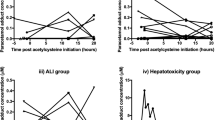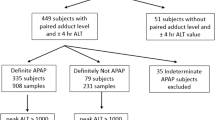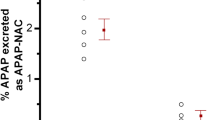Abstract
Elevated concentrations of serum acetaminophen-protein adducts, measured as protein-derived acetaminophen-cysteine (APAP-CYS), have been used to support a diagnosis of APAP-induced liver injury when histories and APAP levels are unhelpful. Adducts have been reported to undergo first-order elimination, with a terminal half-life of about 1.6 days. We wondered whether renal failure would affect APAP-CYS elimination half-life and whether continuous venovenous hemodiafiltration (CVVHDF), commonly used in liver failure patients, would remove adducts to lower their serum concentrations. Terminal elimination half-lives of serum APAP-CYS were compared between subjects with and without renal failure in a prospective cohort study of 168 adults who had ingested excessive doses of APAP. APAP-CYS concentrations were measured in plasma ultrafiltrate during CVVHDF at times of elevated serum adduct concentrations. Paired samples of urine and serum APAP-CYS concentrations were examined to help understand the potential importance of urinary elimination of serum adducts. APAP-CYS elimination half-life was longer in 15 renal failure subjects than in 28 subjects with normal renal function (41.3 ± 2.2 h versus 26.8 ± 1.1 h [mean ± SEM], respectively, p < 0.001). CVVHDF failed to remove detectable amounts of APAP-CYS in any of the nine subjects studied. Sixty-eight percent of 557 urine samples from 168 subjects contained no detectable APAP-CYS, despite levels in serum up to 16.99 μM. Terminal elimination half-life of serum APAP-CYS was prolonged in patients with renal failure for reasons unrelated to renal urinary adduct elimination, and consideration of prolonged elimination needs to be considered if attempting back-extrapolation of adduct concentrations. CVVHDF did not remove detectable APAP-CYS, suggesting approximate APAP-protein adduct molecular weights ≥ 50,000 Da. The presence of urinary APAP-CYS in the minority of instances was most compatible with renal adduct production and protein shedding into urine rather than elimination of serum adducts.



Similar content being viewed by others
References
McGill MR, Sharpe MR, Williams CD, Taha M, Curry SC, Jaeschke H (2012) The mechanism underlying acetaminophen-induced hepatotoxicity in humans and mice involves mitochondrial damage and nuclear DNA fragmentation. J Clin Invest 122(4):1574–83
McGill MR, Jaeschke H (2013) Metabolism and disposition of acetaminophen: recent advances in relation to hepatotoxicity and diagnosis. Pharm Res 30(9):2174–2187
Roberts DW, Pumford NR, Potter DW, Benson RW, Hinson JA (1987) A sensitive immunochemical assay for acetaminophen-protein adducts. J Pharmacol Exp Ther 241(2):527–33
McGill MR, Lebofsky M, Norris H-R, Slawson MH, Bajt ML, Xie Y, Williams CD, Wilkins DG, Rollins DE, Jaeschke H (2013) Plasma and liver acetaminophen-protein adduct levels in mice after acetaminophen treatment: dose–response, mechanisms, and clinical implications. Toxicol Appl Pharmacol 269(3):240–249
McGill MR, Yan HM, Ramachandran A, Murray GJ, Rollins DE, Jaeschke H (2011) HepaRG cells: a human model to study mechanisms of acetaminophen hepatotoxicity. Hepatology 53(3):974–982
Heard KJ, Green JL, James LP, Judge BS, Zolot L, Rhyee S, Dart RC. Acetaminophen-cysteine adducts during therapeutic dosing and following overdose. BMC Gastroenterol 2011; doi: 10.1186/1471-230X-11-20
James LP, Letzig L, Simpson PM, Capparelli E, Roberts DW, Hinson JA, Davern TJ, Lee WM (2009) Pharmacokinetics of acetaminophen-protein adducts in adults with acetaminophen overdose and acute liver failure. Drug Metab Dispos 37(8):1779–1784
James LP, Caparelli EV, Simpson PM, Letzig L, Roberts D, Hinson JA, Kearns GL, Blumer JL, Sullivan JE, Network of pediatric pharmacology research units, national institutes of child health and human development (2008) Acetaminophen-associated hepatic injury: evaluation of acetaminophen protein adducts in children and adolescents with acetaminophen overdose. Clin Pharmacol Ther 84(6):684–690
Khandelwal N, James LP, Sanders C, Larson AM, Lee WM, Acute Liver Failure Study Group (2011) Unrecognized acetaminophen toxicity as a cause of indeterminate acute liver failure. Hepatology 53(2):567–576
Blantz RC (1996) Acetaminophen: acute and chronic effects on renal function. Am J Kidney Dis 28(1):S3–S6
O’Riordan A, Brummell Z, Sizer E, Auzinger G, Heaton N, Grady JG, Bernal W, Hendry BM, Wendon JA (2011) Acute kidney injury in patients admitted to a liver intensive therapy unit with paracetamol-induced hepatotoxicity. Nephrol Dial Transplant 26(11):3501–3508
Hendrickson RG (2011) Acetaminophen. In: Nelson LS, Lewin NA, Howland MA, Hoffman RS, Goldfank LR, Flomenbaum NE (eds) Goldfrank’s toxicologic emergencies, 9th edn. McGraw Hill, New York, pp 483–499
Sheiner LB, Beal SL, Evaluation of methods for estimating population pharmacokinetics parameters (1980) I. Michaelis-menten model: routine clinical pharmacokinetic data. J Pharmacokinet Biopharm 8(6):553–571
Cohen SD, Pumford NR, Khairallah EA, Boekelheide Km Pohl LR, Amouzadeh HR, Hinson JA (1997) Selective protein covalent binding and target organ toxicity. Toxicol Appl Pharmacol 143(1):1–12
Diao L, Beibohm B (2013) Pharmacokinetics and pharmacokinetic-pharmacodynamic correlations of therapeutic peptides. Clin Pharmacokinet 52(10):855–868
Cummings BS, Lasker JM, Lash LH (2000) Expression of glutathione-dependent enzymes and cytochrome P450s in freshly isolated and primary cultures of proximal tubular cells from human kidney. J Pharmacol Exp Ther 293(2):677–685
Hart SGE, Beierschmitt WP, Wyand DS, Khairallah EA, Cohen SD (1994) Acetaminophen nephrotoxicity in CD-1 mice. I. Evidence of a role for in situ activation in selective covalent binding and toxicity. Toxicol Appl Pharmacol 126(2):267–275
McMurtry RJ, Snodgrass WR, Mitchell JR (1978) Renal necrosis, glutathione depletion, and covalent binding after acetaminophen. Toxicol Appl Pharmacol 46(1):87–100
Mitchell JR, McMurtry RJ, Statham CN, Nelson SD (1977) Molecular basis for several drug-induced nephropathies. Am J Med 62(4):518–526
Prescott LF, Illingworth RN, Critchley JAJH, Stewart MJ, Adam RD, Proudfoot AT (1979) Intravenous N-acetylcysteine: the treatment of choice for paracetamol poisoning. Br Med J 2(6198):1097–1100
DeLeve LD (2009) The hepatic sinusoidal endothelial cell: morphology, function, and pathobiology. In: Arias IM, Alter HJ, Boyer JL, Cohen DE, Fausto N, Shafritz DA, Wolkoff AW (eds) The liver. Biology and pathobiology, 5th edn. West Sussex, Wiley-Blackwell, pp 373–388
Smilkstein MJ, Knapp GL, Kulig KW, Rumack BH (1988) Efficacy of oral N-acetylcysteine in the treatment of acetaminophen overdose. Analysis of the national multicenter study (1976–1985). N Engl J Med 319(24):1557–1562
Larson AM, Polson J, Fontana RJ, Davern TJ, Lalani E, Hynan LS, Reisch JS, Schiodt FV, Ostapowicz G, Shakil AO, Lee WM, Acute Liver Failure Study Group (2005) Acetaminophen-induced acute liver failure: results of a United States multicenter, prospective study. Hepatology 42(6):1364–1372
Pakravan N, Simpson KJ, Waring WS, Bates CM, Bateman DN (2009) Renal injury at first presentation as a predictor for poor outcome in severe paracetamol poisoning referred to a liver transplant unit. Eur J Clin Pharmacol 65(2):163–168
Acknowledgments
The authors thank Mitch McGill, Ph. D and Hartmut Jaeschke, Ph. D., University of Kansas Medical Center, for their review and comments during manuscript preparation.
Conflict of Interest
None.
Author information
Authors and Affiliations
Consortia
Corresponding author
Additional information
Michael Levine, Daniel E. Brooks, Rachel Levitan, Joshua Canning, Kimberlie A. Graeme, Aaron B. Skolnik, Carrie A. Truitt, Adam R. Bosak, Frank A. Lovecchio, Robert N. E. French, An Tran, and C. Will Heise.
McNeil Consumer Healthcare provided partial financial support for this study.
Rights and permissions
About this article
Cite this article
Curry, S.C., Padilla-Jones, A., O’Connor, A.D. et al. Prolonged Acetaminophen-Protein Adduct Elimination During Renal Failure, Lack of Adduct Removal by Hemodiafiltration, and Urinary Adduct Concentrations After Acetaminophen Overdose. J. Med. Toxicol. 11, 169–178 (2015). https://doi.org/10.1007/s13181-014-0431-2
Published:
Issue Date:
DOI: https://doi.org/10.1007/s13181-014-0431-2




